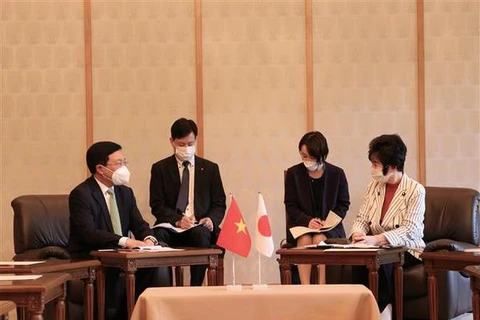Hanoi (VNA) – Vietnam is believed to have much room for exporting coffee to Japan, whose hot coffee market is forecast to grow 4.2 percent during 2020 - 2025, according to Cong Thuong (Industry & Trade) newspaper.
In April, Vietnam shipped 10,540 tonnes of coffee worth 25.9 million USD to Japan, up 39.8 percent in volume and 61.8 percent in value from a year earlier.
The four-month figures reached 45,140 tonnes and 110.13 million USD, respectively rising 13.4 percent and 45.4 percent, according to the General Department of Vietnam Customs.
Coffee export prices stood at 2,440 USD per tonne on average in the first four months, representing a year-on-year increase of 28.2 percent.
Notably, a surge was recorded in the sale of processed coffee to Japan, by 63.6 percent in the first quarter to 16.3 million USD. The product accounted for 19.38 percent of the total coffee shipments to this Northeast Asian country during the period, compared to 16.93 percent in Q1 last year.
GlobalData, a London-based data analytics company, predicted Japan’s hot coffee market will expand by 4.2 percent during 2020 - 2025.
With a population of over 126 million, Japan has high demand for imported agricultural products, including coffee.
In addition, tariff cut commitments in the free trade deals to which both countries are parties like the Vietnam - Japan Economic Partnership Agreement (VJEPA), the ASEAN - Japan Comprehensive Economic Partnership (AJCEP), the Comprehensive and Progressive Agreement for Trans-Pacific Partnership (CPTPP), and the Regional Comprehensive Economic Partnership (RCEP) are also expected to open up big chances for Vietnam’s products, including coffee.
However, Vietnamese coffee has made up just a modest part of Japan’s total imports, Cong Thuong reported.
The newspaper cited the Vietnamese counsellor in Japan as saying that opportunities are considerable for agricultural products, including coffee, but to raise the market share, businesses must meet food safety standards and raw materials be produced under the Good Agricultural Practices (GAP), Hazards Analysis and Critical Control Point (HACCP) or Japanese Agricultural Standards (JAS) systems.
Enterprises were also recommended to set up good relations with major importers of Japan, learn about local consumers’ taste, diversify products designs, improve quality, and reduce production costs./.
In April, Vietnam shipped 10,540 tonnes of coffee worth 25.9 million USD to Japan, up 39.8 percent in volume and 61.8 percent in value from a year earlier.
The four-month figures reached 45,140 tonnes and 110.13 million USD, respectively rising 13.4 percent and 45.4 percent, according to the General Department of Vietnam Customs.
Coffee export prices stood at 2,440 USD per tonne on average in the first four months, representing a year-on-year increase of 28.2 percent.
Notably, a surge was recorded in the sale of processed coffee to Japan, by 63.6 percent in the first quarter to 16.3 million USD. The product accounted for 19.38 percent of the total coffee shipments to this Northeast Asian country during the period, compared to 16.93 percent in Q1 last year.
GlobalData, a London-based data analytics company, predicted Japan’s hot coffee market will expand by 4.2 percent during 2020 - 2025.
With a population of over 126 million, Japan has high demand for imported agricultural products, including coffee.
In addition, tariff cut commitments in the free trade deals to which both countries are parties like the Vietnam - Japan Economic Partnership Agreement (VJEPA), the ASEAN - Japan Comprehensive Economic Partnership (AJCEP), the Comprehensive and Progressive Agreement for Trans-Pacific Partnership (CPTPP), and the Regional Comprehensive Economic Partnership (RCEP) are also expected to open up big chances for Vietnam’s products, including coffee.
However, Vietnamese coffee has made up just a modest part of Japan’s total imports, Cong Thuong reported.
The newspaper cited the Vietnamese counsellor in Japan as saying that opportunities are considerable for agricultural products, including coffee, but to raise the market share, businesses must meet food safety standards and raw materials be produced under the Good Agricultural Practices (GAP), Hazards Analysis and Critical Control Point (HACCP) or Japanese Agricultural Standards (JAS) systems.
Enterprises were also recommended to set up good relations with major importers of Japan, learn about local consumers’ taste, diversify products designs, improve quality, and reduce production costs./.
VNA

























